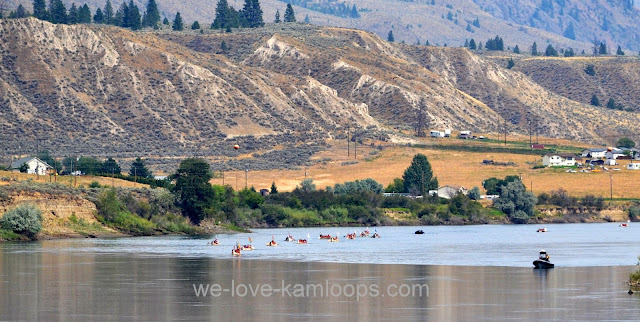The American White Pelican has been making Kamloops a stopover on their migration
travels from their homes farther north.
There are several places they spend the summer months in before making
their way south for the winter. They’ve
been seen in other places on their stopovers in our area but our visit with
them was at Cooney Bay on Kamloops
Lake
 |
| Pelicans group fishing |
In the summer months, they nest in colonies from NE
California to as far north as the Northwest
Territories then migrate south in September or
October. They spend the winter months
near the Pacific Coast
and Gulf of Mexico as far south as Panama , preferring estuaries and
lakes.
 |
| Pelican having a drink |
The American White Pelican will avoid open ocean on their
migrations and favor desert and mountain areas for their travels. I recently heard about the Australian pelican
that gather by the thousands at an inland lake only to have to abandon many of
their young who are too young to fly hundreds of kilometers to survive as the
lake dries up in the summer heat. Thankfully this isn't a problem in this country.
 |
| Pelicans follow the leader |
The Brown Pelican will dive into the water for their fish,
or wait for fisherman’s scraps on the pier as we watched in Texas , but the White catches their fish
while swimming. Their head only will be
below water when they catch the fish in their big bill taking in up to 20
litres then straining out the water.
 |
| Pelican sees a fish |
We saw a flock of pelicans on a visit to the Salton Sea in Southern California last spring. There are lots of fish in this sea which
makes for a great feeding area for them.
Tilapia in abundance would make fishing easy for these large birds. Click here to see those, some of whom just
may be in Kamloops
first, and learn more about their size and wing span.
 |
| Fish sighting causes some excitement |
The pelican is a very large bird and adults will eat 4
pounds of fish every day. The pelicans
are usually in a group of 12 or more and will corral the fish for one another.
There are times they fight over the catch but I guess that would depend on the
supply; there did not appear to be any fighting here.
 |
| Fish sighting |
These pelicans were near where the Tranquille Creek comes into the lake, bringing a supply of fish
to them including the rainbow trout.
They’d float back and forth near the mouth of the creek and occasionally
we’d see one reach down for a fish, this often brought a flurry of others to
that spot, too.
 |
| Pelican scatter across Kamloops Lake, BC |
We counted about 30 pelicans on Kamloops Lake
 |
| Pelican came up empty |
Pelicans were removed from the national endangered species list
in 1987 but they’re still considered endangered in Alberta
and protected in all of Canada .
The numbers have increased but not to the point they’ve been in the past, but
hopefully that will change.
 |
| Pelicans coming in for a landing |
The pelicans don’t stay for long so it was a great treat to
be able to see them during their brief stay here. They’re making their way
south for the winter months then return to their nesting grounds in March and
April. It was entertaining to watch them
come in for their landings, which is skipping along the water until they slow
down enough to land.
 |
| Kamloops Lake, BC |
The access to Cooney
Bay
What a great way to spend some time and just another reason why there is no place like home.
















































